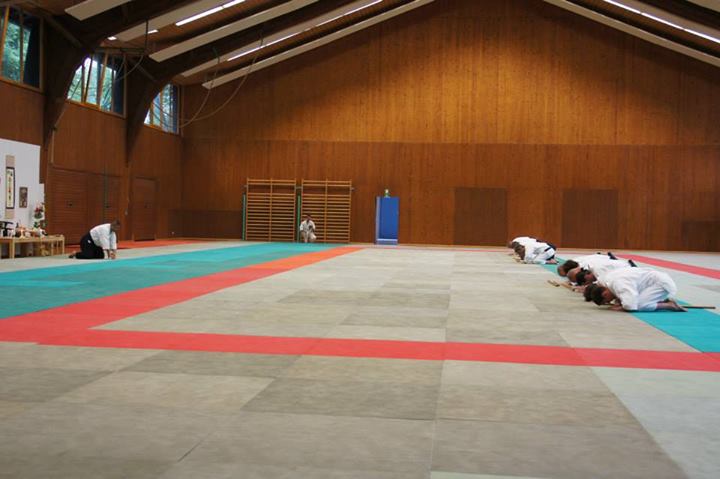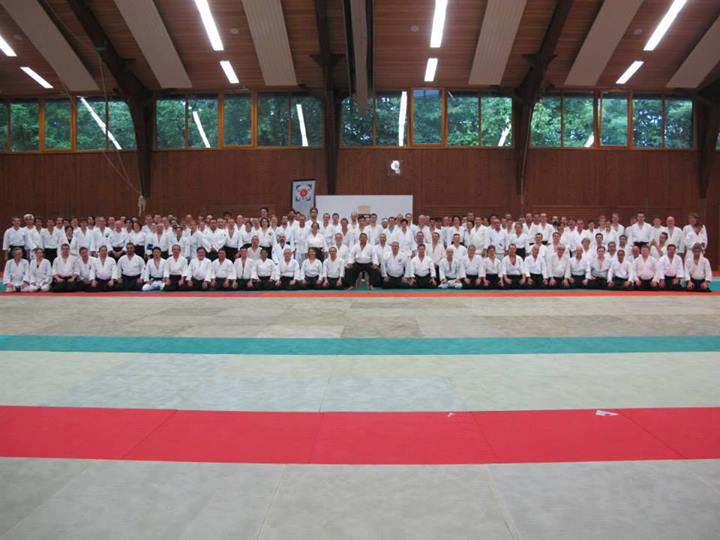Article by Tim Haffner
The Aiki-Shuren Dojo in Korntal-Munchingen, a suburb of Stuttgart, Germany was pleased to host Saito Hitohira, Kaicho of the Iwama Shin Shin Aiki Shurenkai, from 31 May to 2 June 2013. Over 140 Aikidoka from 15 different countries, including Germany, France, Italy, Lebanon, the United States and Russia, came to a sports center campus to participate in one of the few European seminars Kaicho will conduct in 2013. The sports center offered lodging, meals and training space for all participants without the need to leave the campus.
Filled with anecdotes and quotations of the direct oral teachings (Kuden) of Aikido Founder, Ueshiba Morihei O’sensei, Kaicho demonstrated a variety of techniques over three days of training that were firmly rooted in the Kihon Waza fundamentals characteristic of Iwama-ryu Aikido. Beginning with Aiki-Ken on Friday evening, Kaicho emphasized the need for every aikidoka to focus on precision in the basic sword suburi. Demonstrating how using the spine (sebone), top of the head (atama) and naval (o-heso) are used as common reference points for all basic cutting practices, Kaicho demonstrated that power and speed are generated from a solid foundation in the principles of sword. This precision is particularly important when working with a live blade during tameshigiri test cutting practice. Kaicho relayed how an improper angle of the blade by only a matter of a few millimeters would cause bamboo to repel the sword. For this reason, alignment of the sword, grip, shoulders and hanmi must be strictly exact.
Additionally, Saito Kaicho emphasized the need to change the angle of the shoulders in relation to an opponent while conducting an advancing cut, like those in the 4th through 7th suburi, in order to avoid being struck. It is the study of angles in motion that allow for the “awase” in Aikido. This study is essential for understanding not only the principles of Aikido, but also the combative applications of sword technique.
An interesting note came in a correction Kaicho offered when attempting to explain “awase”. In Aikido, he said, awase is more than just blending with the opponent or an attack. There is really no accurate way to translate the essence of awase, it is a concept that must be studied, experienced and adopted for its own sake. According to Kaicho, you must have a sense of complete emptiness in order to adequately experience awase in reality. This was demonstrated as Kaicho performed the role of Uchi-tachi in the first movement of the 3rd Kumi-tachi. The speed and power shown could only be generated from a state of awareness, emptiness and readiness for awase with Uke-tachi’s opening movement. The experience of receiving Kaicho’s yokomen strike during this phase of the 3rd Kumi-tachi led his partner to later remark, “it made the hairs on the back of my head stand up”.
After demonstrating all five of the Kumi-tachi, along with at least one henka variation and nage waza throwing technique for each, Kaicho’s taijutsu instruction focused on ushiro waza. Demonstrating a variety of techniques for ushiro eri-dori, ushiro ryokata-dori, ushiro ryote-dori and ushiro katate kubijime attacks, the variety of applications included controlling locks and dynamic throws.
Saturday afternoon included a SanDan test by Björn Rosenstiel and YonDan tests performed by Nicola Joliot and Julian Bever. At the conclusion of training YonDan menjyo was presented to Michele Marolla of Trieste and Volker Hochwald of Korntal received GoDan.
The special keiko session on Sunday morning emphasized ushiro ki no nagare waza and Kaicho later spoke during private conversation about how training in attacks from the rear helped to develop an intuitive awareness of perceiving hostile intent that O’sensei called “hasshi kizashi”. Indeed, Kaicho’s evolution of techniques for rear attacks showed how this intuitive sense allows for the skillful application of kokyu-ryoku power in action.*
The seminar concluded with two sessions of Aiki-Jo, highlighting Kumi-jo paired partner practices. Again, precision in the basic suburi was emphasized as a prerequisite for effective partner practice. Of special note was Kaicho’s demonstration of the fast finish to the 2nd Kumi-jo, stating that the final movement of Uke-jo, raising the front foot while parrying a strike to the knee and finishing with tsuki, was “O’sensei’s form”. Additionally, Kaicho taught the second variation to the 4th Kumi-jo, which involves Uke-tachi responding to a tsuki attack with katate hachi-no-ji gaeshi and evading a second tsuki while executing a jodan tsuki.
Kaicho’s delivery of detailed instruction was remarkably vigorous in light of recent surgeries to his wrist and knee. Not only was he able to move quickly, but also perform throws that involve rapidly moving from standing to kneeling positions.
While technical precision was the focus of training, Kaicho stated that he most enjoyed seeing a number friends, “old faces” and enthusiastic students coming together to practice in a harmonious atmosphere. Breaks from training, relaxing after hours and the dinner party on Saturday evening offered the chance for conversation, reminiscing and the strengthening the sense of community among fellow travelers on the Aiki path.
Kaicho relayed stories of the sacrifices his family made in attending to O’sensei and his wife Hatsu. He said that serving O’sensei was severe added that he expected a lot from those around him, “because he was severe with himself”. This was true in his everyday life as well as training in budo. It is this example of dedication that inspires the disciplined practice of Aikido found in the Iwama Shin Shin Aiki Shurenkai.
The Aiki Shuren Dojo of Korntal would like to express appreciation for the participants who attended the event, as well as the myriad people who worked to make the seminar a great success, and most of all, for Saito Hitorhira Sensei for his great instruction, friendship and leadership.
*A more detailed explanation of Hasshi Kizashi can be found on page 8 in Kaicho’s book: Aikido Basic Technique, Iwama Shin Shin Aikido, Volume 1, available at:
http://www.iwamaaikido.com/english/publication/
Photos from: Thomas Podzelny and Alexandr Kravchuk


